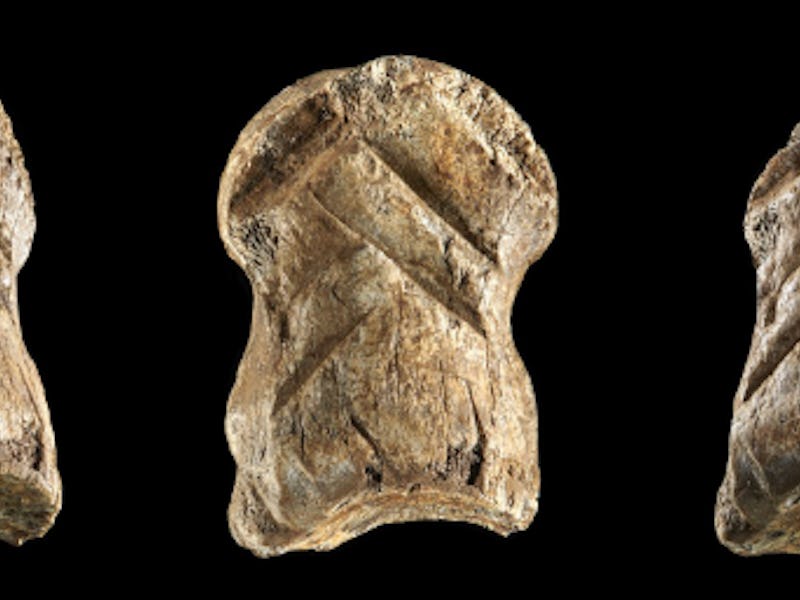51,000-year-old engraved bone reveals new details about Neanderthal culture
This is no ordinary fossil.

Nestled in the rugged north German hills, there lies the whimsically named Einhornhöhle or Unicorn Cave. The name stems from medieval treasure hunters, who once plundered the cave and its surroundings for what they thought to be unicorn bones.
But while unicorns remain the stuff of fantasy, one bone that today’s scientists have found at the cave is very much real and much more exciting.
Published in a paper this week in the journal Nature Ecology and Evolution, a team of archeologists describes the discovery of a carved bone fragment — what they call “an intentional object” — created by the cave’s real former inhabitants: Neanderthals.
What’s new — At first this bone — a giant deer’s toe — didn’t seem too remarkable. Archeologist Dirk Leder and his team initially found the bone in September of 2019, and might have filed it away as just another giant deer bone — but it seemed to have scores across its surface.
The bone is small, only about five centimeters high and three centimeters wide, and is scored with deep lines that run parallel and perpendicular to one another, like a hatch or herringbone pattern.
The scores were interesting but baffling. It wasn’t until after cleaning and analysis they realized just how much of an anomaly this find really was.
“Now we’re certain we’re dealing with an intentional object that tells us about Neanderthal cognitive behavior,” Leder tells Inverse.
This 51,000-year-old engraved deer bone found in Unicorn Cave indicates that Neanderthals had more capacity for symbolic thinking than we thought.
The discovery — Initially, the scientists supposed Homo sapiens — our species — must have made the marks. The surprise came after radiometric dating — the sample was too old to be made by humans.
At that moment, Leder realized this was no Homo sapiens-produced piece of work — it had to be Neanderthals. The bone carvings were made 51,00 years ago, the findings suggest, and the only denizens of Europe during that time (as far as we know) were Neanderthals.
Not only did the Neanderthals intentionally carve this bone, but Leder speculates that this object most likely was a pendant or talisman that may have been carried around by Neanderthals, much like some people today wear religious jewelry or carry keepsakes for luck in their wallet.
The deep scores initially baffled scientists — but Neanderthals likely made them intentionally, and gave them clear meaning.
Why it matters — This discovery adds to mounting evidence that Neanderthals could both think and communicate in the abstract. In other words, they may have had the same ability to create, innovate, and imagine as did ancient Homo sapiens at the time. Another blow to human uniqueness dealt by science — and a fascinating pathway for future research.
We have a few other engravings like this one to go on. In Gorham’s Cave in Gibraltar, there’s a carving of a “#” symbol that’s is also ascribed to Neanderthals. Other such creative artifacts include a decorated raven bone found in Crimea and another engraved bone at a Neanderthal burial site in La Ferrassie in France.
“It shows us Neanderthals were capable of communicating through symbols,” Leder says.
Some experts think there’s also significance to the fact that this piece came from a giant deer, which would have been a rare get for Neanderthals. It may have carried more cache culturally.
The deer bone appears to be scored with a chevron pattern to depict an abstract image of anything from a landscape to a person.
What’s next — This bone will not settle the debate on how intellectual other ancient human species actually were, but it adds to the mountain of evidence for Neanderthals’ capacity for symbolic thinking.
As for the interpretation of the markings? That’s anybody’s guess. Leder’s own reading is that it’s a depiction of a triple mountain range, or of pine trees in the region — but to know exactly what they are might be beyond the abilities of science.
But Leder and his team are not giving up to rest on their laurels. They plan to return to Unicorn Cave and search for another find like this one — it was a chance discovery made at the entry to the cave, and more may be lurking in the cave’s interior. For Leder, one of the biggest mysteries the work might shine a light on is how the human brain and our psychological selves developed.
Abstract: While there is substantial evidence for art and symbolic behaviour in early Homo sapiens across Africa and Eurasia, similar evidence connected to Neanderthals is sparse and often contested in scientific debates. Each new discovery is thus crucial for our understanding of Neanderthals’ cognitive capacity. Here we report on the discovery of an at least 51,000-year-old engraved giant deer phalanx found at the former cave entrance of Einhornhöhle, northern Germany. The find comes from an apparent Middle Palaeolithic context that is linked to Neanderthals. The engraved bone demonstrates that conceptual imagination, as a prerequisite to compose individual lines into a coherent design, was present in Neanderthals. Therefore, Neanderthal’s awareness of symbolic meaning is very likely. Our findings show that Neanderthals were capable of creating symbolic expressions before H. sapiens arrived in Central Europe.